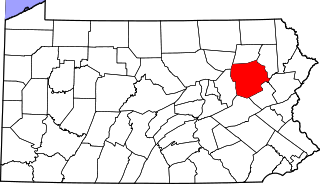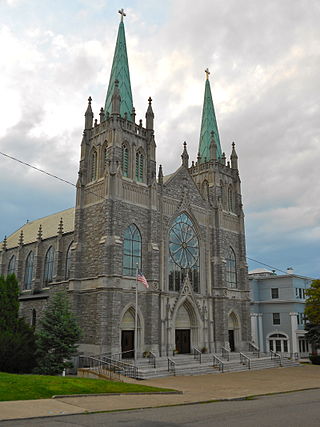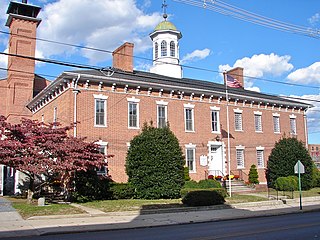
Luzerne County is a county in the Commonwealth of Pennsylvania. According to the United States Census Bureau, the county has a total area of 906 square miles (2,350 km2), of which 890 square miles (2,300 km2) is land and 16 square miles (41 km2) is water. It is Northeastern Pennsylvania's second-largest county by total area. As of the 2020 census, the population was 325,594, making it the most populous county in the northeastern part of the state. The county seat and largest city is Wilkes-Barre. Other populous communities include Hazleton, Kingston, Nanticoke, and Pittston. Luzerne County is included in the Scranton–Wilkes-Barre–Hazleton Metropolitan Statistical Area, which has a total population of 555,426 as of 2017.

Forty Fort is a borough in Luzerne County, Pennsylvania, United States. The population was 4,233 at the 2020 census. Its neighbors are Wyoming, Plains Township, Kingston, and Swoyersville. The Wilkes-Barre Wyoming Valley Airport and the Wyoming Seminary Lower School are both located in the borough.

Kingston is a borough in Luzerne County, Pennsylvania, United States. It is located on the western bank of the Susquehanna River opposite Wilkes-Barre. Kingston was first settled in the early 1770s, and incorporated as a borough in 1857. As of the 2020 census, the population was 13,349, making it the most populous borough in Luzerne County.

Wyoming is a borough in the Greater Pittston area of Luzerne County, Pennsylvania, United States. It is located 5 miles (8 km) north of Wilkes-Barre, along the Susquehanna River. The population was 3,097 as of the 2020 census.

The Battle of Wyoming, also known as the Wyoming Massacre, was a military engagement during the American Revolutionary War between Patriot militia and a force of Loyalist soldiers and Iroquois warriors. The battle took place in the Wyoming Valley of Pennsylvania on July 3, 1778 in what is now Luzerne County. The result was an overwhelming defeat for the Americans. There were roughly 300 Patriot casualties, many of whom were killed by the Iroquois as they fled the battlefield or after they had been taken prisoner.
The Luzerne County Historical Society is one of the oldest continually operating local historical societies in America. It was founded on February 11, 1858, in recognition of the 50th anniversary of the first successful burning of anthracite coal by Jesse Fell, and was originally named the Wyoming Historical and Geological Society. The organization operates the historic Swetland Homestead in Wyoming, Pennsylvania and the Luzerne County Museum which also features a separate research library in Wilkes-Barre, Pennsylvania. It also administers the Nathan Denison house.

The 1696 Thomas Massey House is one of the oldest English Quaker homes in the Commonwealth of Pennsylvania. It is a 2-story brick and stone house, originally constructed by the English, Quaker settler, Thomas Massey in 1696. It is located on Lawrence Road near Sproul Road in Broomall, Pennsylvania.

This is a list of the National Register of Historic Places listings in Luzerne County, Pennsylvania.

Fort Gaddis is the oldest known building in Fayette County, Pennsylvania and the second oldest log cabin in Western Pennsylvania. It is located 300 yards (270 m) east of old U.S. Route 119, near the Route 857 intersection in South Union Township, Pennsylvania. Fort Gaddis was built about 1769-74 by Colonel Thomas Gaddis who was in charge of the defense of the region, and his home was probably designated as a site for community meetings and shelter in times of emergency, hence the term "Fort Gaddis," probably a 19th-century appellation. It is a 1 1/2-story, 1-room log structure measuring 26 feet long and 20 feet wide.

Birmingham Friends Meetinghouse is a historic Quaker meeting house at 1245 Birmingham Road in Birmingham Township, Chester County, Pennsylvania. The current meetinghouse was built in 1763. The building and the adjacent cemetery were near the center of fighting on the afternoon of September 11, 1777 at the Battle of Brandywine. Worship services are held weekly at 10am. The meetinghouse and adjacent octagonal schoolhouse were listed on the National Register of Historic Places as Birmingham Friends Meetinghouse and School on July 27, 1971.

Forty Fort Meetinghouse is a historic meeting house at River Street and Wyoming Avenue in the Old Forty Fort Cemetery in Forty Fort, Luzerne County, Pennsylvania. It was built in 1806–08 in a New England meeting house style with white clapboard siding and was added to the National Register of Historic Places in 1988.

Luzerne Presbyterial Institute, also known as the Wyoming Institute is a historic church school on Institute Street in Wyoming, Pennsylvania. It was built in 1849 for use as a school, the Luzerne Presbyterial Institute, which closed in 1869. The building was then used as a Sunday school by the Wyoming Presbyterian Church. It was added to the National Register in 1979.

St. Gabriel's Catholic Parish Complex is a historic Roman Catholic church complex located at 122-142 S. Wyoming Street in Hazleton, Luzerne County, Pennsylvania within the Diocese of Scranton.

Plymouth Friends Meetinghouse is a historic Quaker meeting house located at the corner of Germantown Pike and Butler Pike in Plymouth Meeting, Montgomery County, Pennsylvania. It is part of the Plymouth Meeting Historic District, and was added to the National Register of Historic Places in 1971.

The Chads House, which was built by John Wyeth Jr. for John Chads, is located in Chadds Ford, Delaware County, Pennsylvania. The house was built after 1712 and was added to the National Register of Historic Places on March 11, 1971. John Chad's widow, Elizabeth, stayed in the house while it was in the line of fire during the Battle of Brandywine. The city of Chadds Ford relied on the spring ford on the property, and thus the city was named after John Chads.

The Old Franklin County Jail is a historic jail located at Chambersburg in Franklin County, Pennsylvania. It was built in 1818, and is a two-story, brick building with a slate covered hipped roof topped by a cupola. The original building measures 84 feet wide by 48 feet deep. In 1880, a cell block was added. The jail yard is divided into two sections and surrounded by a 20-foot-high wall. At least seven prisoners were hanged on the premises.

Heinrich Zeller House, also known as Fort Zeller and Zeller's Fort, is a historic 1+1⁄2-story building that has served as a fort, block house and residence. The historic structure is located in Millcreek Township, Lebanon County, Pennsylvania.

The Luzerne County Courthouse is a historic county courthouse located in Wilkes-Barre, Luzerne County, Pennsylvania. The building houses the government of Luzerne County.

The Swetland Homestead is an historic, American home that is located in Wyoming, Luzerne County, Pennsylvania.
Thomas Henry Atherton Jr., was an American architect and decorated World War I officer. He designed many public buildings in New York and Pennsylvania and a war memorial in France. A number of his works, including numerous National Guard armories in eastern Pennsylvania, are listed on the U.S. National Register of Historic Places.
























